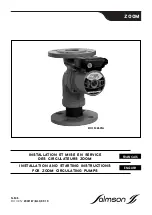
8
GB
Step 2: Release torch button
° The set welding current is automatically reached after the up-slope time (0.1 sec)
has elapsed.
Step 3: Activate the torch button once again
° The welding current falls to 20% of the welding current set on the main current
potentiometer for the duration of the downslope time
° The welding current remains at this 20% level.
Step 4: Release torch button
° The arc is extinguished
° The shielding gas continues to flow for the duration of the gas post-flow time.
In the latched torch button operation mode, the operator does not need to keep the torch
button pressed, allowing welding for a relatively long period of time without fatigue.
6.1.5
Gas post-flow timer (0.5 s
–
25.0 s)
The gas post-flow time
is the time which elapses after the arc is extinguished and before
the shielding gas solenoid valve is de-energised. The shielding gas protects both the
workpiece and the tungsten electrode from contamination form the surrounding atmosphere
until they have cooled down sufficiently.
6.1.6
Downslope timer Crater fill (0.0 s
–
10.0 s)
The downslope timer
is the time during which the welding current decays to the crater fill
current. In the Non-latched operation mode, the downslope time begins as soon as torch
button 1 is released. In the Latched operation mode, the downslope time commences when
torch button 1 is activated during welding. The longer the setting of the downslope time, the
lower the risk of creating end crater cracking.
6.1.7
Manual Pulsing function
If the torch button is activated during the downslope when in the non-latched TIG 2 mode,
the welding current immediately rises to the value set on the main current setting
potentiometer. The length of each pulse and is manually controlled by the operator
depending upon when he activates the torch button, as a result the average heat input will be
reduced.
6.2
Stick Electrode (MMA) welding
6.2.1
Stick Electrode welding in the Fuse Hold
mode
In this mode of operation, the actual current drawn from the mains is continuously monitored.
If necessary, the welding current is reduced to the level required to prevent the mains fuse
form tripping out. A quick acting miniature circuit breaker similar to the type normally installed
in households should be installed in the mains supply cabinet as the Fuse Hold function is
designed for use in conjunction with this type of circuit breaker.
The machine is designed for use with all the common types of stick electrodes. The
maximum current is 140 A for the TIGER 170 and 160 A for the TIGER 210. If a higher
current is set, the current is automatically limited to 140 A / 160 A.
This current is usually sufficient to weld most common types of stick electrodes of up to
3.25mm diameter.











































